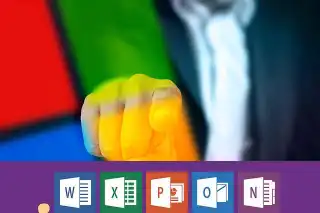MICROSOFT OFFICE
From Basic to Advance
“Progress is impossible without change, and those who cannot change their minds cannot change anything.”George Bernard Show
Office courses are an essential skill-set in today’s high tech world. With the increasing use of Microsoft Office, it is important that professionals know how to work with Office products.
With many companies now using Office 365, the demand for professionals who can use its diverse range of applications has increased dramatically.
The skills acquired in these courses can also be applied to other software such as Google Drive and Apple Pages, which can increase productivity and complete work faster of employees.
PROGRAMS OFFERED
- Excel
- Adv Excel
- Powerpoint
- Excel Macros
- MS Project
- Power Bi
- Word
- One Note
- Access
- Outlook
- Teams
- MS Visio
Introduction to Microsoft Excel (Basic)
Duration: 2 Day
Course outline
Creating a Microsoft Excel Workbook
- Starting Microsoft Excel
- Creating a Workbook
- Saving a Workbook
- The Status Bar
- Adding and Deleting Worksheets
- Copying and Moving Worksheets
- Changing the Order of Worksheets
- Splitting the Worksheet Window
- Closing a Workbook
The Ribbon
- Tabs
- Groups
- Commands
The Backstage View (The File Menu)
- Introduction to the Backstage View
- Opening a Workbook
- Open a Workbook
- New Workbooks and Excel Templates
- Select, Open and Save a Template Agenda
- Printing Worksheets
- Print a Worksheet
- Adding Your Name to Microsoft Excel
- Adding a Theme to Microsoft Excel
The Quick Access Toolbar
- Adding Common Commands
- Adding Additional Commands with the Customize Dialog Box
- Adding Ribbon Commands or Groups
- Placement
- Customize the Quick Access Toolbar
Entering Data in Microsoft Excel Worksheets
- Entering Text
- Adding and Deleting Cells
- Adding a Hyperlink
- Add WordArt to a Worksheet
- Using AutoComplete
- Entering Text and Using AutoComplete
- Entering Numbers and Dates
- Using the Fill Handle
- Entering Numbers and Dates
Formatting Microsoft Excel Worksheets
- Selecting Ranges of Cells
- Hiding Worksheets
- Adding Color to Worksheet Tabs
- Bold, italicize and underline text.
- Add borders to cells.
- Change text and cell colors.
- Change the font and font size.
- Align text.
- Wrap text.
- Indent text.
- Merge and center text.
- Change number formats.
- Change date formats.
- Show decimals.
- Adding Themes to Workbooks
- Customize a Workbook Using Tab Colors and Themes
- Adding a Watermark
- The Font Group
- Working with Font Group Commands
- The Alignment Group
- Working with Alignment Group Commands
- The Number Group
- Working with Number Group Commands
Using Formulas in Microsoft Excel
- Math Operators and the Order of Operations
- Entering Formulas
- AutoSum (and Other Common Auto-Formulas)
- Copying Formulas and Functions
- Relative, Absolute, and Mixed Cell References
- Working with Formulas
Working with Rows and Columns
- Inserting Rows and Columns
- Deleting Rows and Columns
- Transposing Rows and Columns
- Setting Row Height and Column Width
- Hiding and Unhiding Rows and Columns
- Freezing Panes
- Working with Rows and Columns
Editing Worksheets
- Find
- Find and Replace
- Using Find and Replace
- Using the Clipboard
- Use Find and Replace to quickly replace data with other data.
- Use the Cut, Copy, Paste and Format Painter commands to edit worksheets.
- Using Format Painter
- Managing Comments
Finalizing Microsoft Excel Worksheets
- Setting Margins
- Setting Page Orientation
- Setting the Print Area
- Print Scaling (Fit Sheet on One Page)
- Printing Headings on Each Page/Repeating Headers and Footers
- Headers and Footers
- Preparing to Print
Advance Excel
Duration 2 – 3 Days
Content
Using Functions & Formulas
- Use SUM, AVERAGE, MIN, MAX, COUNT and COUNTA functions
- Use logical functions (IF, OR, AND & NOT)
- Use math & statistical functions
- Use the PMT function
- Use data functions (YEAR, DAYS360 & NETWORKDAYS)
- Calculate time
- Create array formulas
- Use VLOOKUP, MATCH & INDEX functions
- Validate data
- Use database functions
- Import & export text files
- Import & export XML data
- IRR, PV, NPV
- Use Goal Seek & Solver
- Use the Analysis ToolPak(Regression, correlation etc.),
Using Pivot Tables
- Creating Pivot Tables
- More PivotTable Functionality
- Inserting Slicers
- Multi-Select Option in Slicers
- PivotTable Enhancements
- Working with Pivot Tables
- Inserting Pivot Charts
- More Pivot Table Functionality
- Working with Pivot Tables
Auditing Worksheets
- Tracing Precedents
- Tracing Dependents
- Showing Formulas
- Audit formulas
- Trace precedents to determine which cells impact a specific cell.
- Trace dependents to determine which cells are impacted by a specific cell.
- Remove precedent and dependent arrows.
- Show formulas.
- Check for errors frequently found in formulas
Data Tools
- Converting Text to Columns
- Linking to External Data
- Controlling Calculation Options
- Data Validation
- Using Data Validation
- Consolidating Data
- Goal Seek
- Using Goal Seek
Working with Others
- Protecting Worksheets and Workbooks
- Password Protecting a Workbook
- Password Protecting a Worksheet
- Password Protecting Ranges in a Worksheet
- Marking a Workbook as Final
Recording and Using Macros
- Recording Macros
- Recording a Macro
- Running Macros
- Editing Macros
- Adding Macros to the Quick Access Toolbar
- Adding a Macro to the Quick Access Toolbar
Random Useful Items
- Sparklines
- Inserting and Customizing Sparklines
- Using Microsoft Translator
- Preparing a Workbook for Internationalization and Accessibility
- Importing and Exporting Files
- Importing Text Files
- Copying Data from Excel to Word
- Copying Charts from Excel to Word
- Change colors
Microsoft Powerpoint
Duration 0.5 – 2 Days
Content
Introduction
- Task assignment
- Beginning with a new slide
- Working with text: adding, moving, or re coloring
- Inserting an image into a slide
- Animating text
- Creating transitions between slides
- Slide show options
- Keyboard shortcuts to use with your slide show
- Ideas for Using PowerPoint in a Classroom
Add & Editing
- Adding two one-digit numbers without regrouping.
- Inserting and editing a Text Box
- Drawing a rectangle and changing the Fill Color
- Inserting and resizing Clip Art
- Copying and pasting Clip Art images
- Copying and pasting slides in the Slide Sorter view
- Grouping screen elements
- Animating screen elements
Animation & Charts
- Animating a Chart
- Changing the Slide Color Scheme of a template
- Re coloring
- Ungrouping
- Using the Line Tool to Produce a Step-by-Step Presentation Using Action Buttons in a PowerPoint show
- Formatting action buttons to change their look or their action
- Using Invisible Action Buttons in a PowerPoint Show
- Using MS Equation to Write Mathematical or Scientific Equations
- Using Sound in a PowerPoint
- Using different slide views
Advance Functions
- Use smart guides
- Use text fill and outline Add text effects
- Insert SmartArt
- Use alignment guides
- Align and distribute objects
- Format a table
- Add a sound and video clip Record audio
- Modify rows and columns Check spelling
- Use the Research Task Pane
- Use proofing and translating tools Prepare their presentations
- Use slide masters
- Share their presentations
Excel Macros
Duration 2 Day
Content
Configuring Excel for Macros
- The Developer Tab
- Macro Security
- Trust Center
- Saving Files
Basic Macro Recording
- The Record Macro Window
- Rules for Macro Names
Running Macros
- Running a Macro from the Developer Tab
- Running a Macro Using a Shortcut Key
- Running a Macro from a Button
- Running a Macro from a Worksheet Object
Creating Dynamic Macros
- Absolute versus Relative References
- Effective Range Selection
- The Importance of the Cursors Position
- Handling Empty Cells in a Data Range
Using Functions and Formulas in Macros
- Creating dynamic formulas
- Filling Formulas
- Using Data Tables
- Deleting Empty Rows at the End of a Worksheet
- Functions with Dynamic Ranges
Working with Files
- The Personal Macro Workbook
- Using Hyperlinks
- Writing Macros that Work on Variable File Names
- Importing a Text File
Macros for Data Entry
- Creating a worksheet to use as a Data Entry Form
- Creating a macro to add the data to a table
MS PROJECT
Duration 2 Days
Training Objectives
This is a hands-on, practical approach to the concepts and application of project management using Microsoft Project as the scheduling software. In this lab participants will learn how to set up project plans, use Microsoft Project communication tools, and manage their projects.
Content
Basic
- Understanding Project
- Understanding and configuring Project Essentials
- Reviewing different views – Gantt, Network (PERT), Calendar
- Starting on a Sample Project
Tasks
- Understanding Task view – Gantt Chart
- Task Categories
- Task Dependencies (Relations)
- Task Constraints
- Task Types – Impact of Task Types
Resources Cost
- Understanding different ways of Resource Entry
- Understanding Resource Sheet – reviewing all columns
- Applying Leave/Timings/Rates per resource
- Resource Allocation, Applying Cost
- Understanding Resource Usage
- Difference between Resource Usage and Task Usage
- Resource Over-allocation
- Leveling Resource Over-allocation
- Resource Pool – sharing resources among multiple projects
Baseline, Interim Plan Progress Lines Tracking
- Saving Baseline
- Comparing Baseline
- Understanding Project Statistics
- Using Progress Lines
- Understanding Tracking toolbar and Tracking the Project
Different View & Reports
- Understanding different views – Baseline, Cost, Work
- How to create, modify different Reports
Multiple Projects
- Handling multiple Projects – different ways
- Sharing tasks among Projects
Microsoft Power BI
Duration: 2 days
Including: PowerPivot, Power Query, Power View, Power Map
Content
PowerPivot
- What is PowerPivot for Excel Importing Your Data
- Creating a PowerPivot Data Model Creating PivotTables with PowerPivot Creating a Date Table
- Using Slicers to Filter Data
- Connecting Slicers to more than one PivotTable
- Using Charts and Slicers to create interactive Dashboards Using DAX
- Creating Calculated Columns
- Creating Calculated Fields
- Implicit and Explicit Calculated Fields
- Using DAX aggregate functions in a PowerPivot PivotTable Using CountRows and DistinctCount Functions
- The difference between evaluations using Row Context and evaluations using Filter Context.
- Advanced DAX functions: SUMX and CALCULATE Time Intelligence Functions
- Creating Key Performance Indicators Using PowerPivot Sets
Power Query
- Adding Data to Power Query from various data sources
- Creating a Query, the Query Editor Window
- Load to Worksheet and Load to Data Model Remove Duplicate Data in Columns
- Split and Merge Columns of Data Group data to create summary Queries Merge and Append Queries
- Transpose Data to swap Rows and Columns
- Filling data Down to populate missing values
- Unpivot Columns: flatten a “cross tab” table Duplicate Columns
- Creating Custom Columns and Additional Date Columns
- Working with Applied Steps
- Importing Data From a Folder
Power View
- The Power View Field List Using Text Boxes Creating Tables
- Changing Table Visualisations
- Using a Matrix and Enable Drill Down
- Using Cards; Setting up Titles and Pictures for Cards
- Creating Chart Visualisations and Interactive Charts Creating Power View Slicers
- Using Tiles
- Using Power View Filters
- Working with interactive Bubble Charts using the Play Axis Creating Power View Maps
Power Map
- Create a Power Map and Plot Geographic Data
- Creation Visualisation; Column, Bubble, Heatmap, Regions Using the 3-D Environment
- Using Charts with Power Maps
- Working with Layers and adding Scenes Adding Annotations
- Visualising Data over Time
- Playing the Tour
Microsoft Outlook
Duration 0.5 to 1 day
In this course, you will use Outlook to send, receive, and manage email messages, manage your contact information, schedule appointments and meetings, create Tasks and Notes for yourself, and customize the Outlook interface to suit your working style.
Course Content
Getting Started with Outlook 2019/365
- Navigate the Outlook Interface
- Work with Messages
- Add Message Recipients
- Check Spelling and Grammar
- Format Message Content
Customizing Message Options
- Customize Reading Options
- Track Messages
- Recall and Resend Messages
- Attach Files and Items
Working with Tasks and Notes
- Create a Task
- Print a Task
- Update a Task
- Search for Tasks
- Assign a Task
- Reply to a Task Request
- Track Tasks
- Change Your Task View
- Work with Notes
Using Signature and Themes
- Create a Signature
- Automatically Add a Signature
- Modify a Signature
- Format Outgoing Messages
- Create and Apply a Theme
Managing Your Inbox
- Search for Messages
- Create Search Folders
- Sort Messages
- Add New Local Folders
- Move Messages between Folders
- Group Your Mailbox Items
- Filter Messages
- Organize Messages
- Create and Manage Rules
- Manage Your Junk Email
- Archive Your Messages
- Create an Outlook Data File
- Create a Quick Step
- Add Protection to Your Outgoing Messages
- Create Auto-replies
Working with Multiple Email Accounts
- Setting Up Multiple Accounts in Outlook
- Send Emails from Different Accounts
- POP vs. IMAP Email Programs
Working with the Calendar
- View the Calendar
- Create Appointments
- Schedule Meetings
- Print the Calendar
Microsoft One Note
Duration 0.5 to 1 Day
Course Content
- Introduction to one note
- Using Office 365 / App on system
- Navigate the OneNote Environment
- Use Templates
- Customize the OneNote User Interface
- Apply Formatting to Notebook Content
- Insert Images and Audio into a Notebook
- Add Quick Notes and Links
- Use Drawing Tools
- Using dictation in note
- Embed Excel Spreadsheets
- Attach Other File Types
- Use Tags
- Organize and Search Notebooks
- Proof and Print a Notebook
- Configure Password Protection and Notebook Properties
- Export Content from OneNote Notebooks
- Back Up and Restore Notebook Content
- Send OneNote Content in Other Formats
- Share OneNote Content by Using OneDrive
Introduction
- Features of Access Database
- Introduction to Objects
- Tables
- Relations
- Queries
- Reports
- Macro
Tables
- Statistics
- Create Table Structure
- Understand Table Fields
- Field Types & Limitations
- Field Properties
- Understanding Joins
- Setting Relations
- Understand Primary Key
- Understand Foreign Key
- Entering Data
- Introduction of Application
- Creating Example Tables
- Masking Properties
Queries
- Introduction to Queries
- Types of Queries
- Meaning and Uses of Different Queries
- Select
- Parameterized
- Joins
- Delete
- Update
- Make Table
- Append
- Cross-tab
Experiment with data model
Revision
- Tables
- Relations
- Queries
- Complete Model
Microsoft Outlook
Duration 0.5 to 1 day
In this course, you will use Outlook to send, receive, and manage email messages, manage your contact information, schedule appointments and meetings, create Tasks and Notes for yourself, and customize the Outlook interface to suit your working style.
Course Content
Getting Started with Outlook 2019/365
- Navigate the Outlook Interface
- Work with Messages
- Add Message Recipients
- Check Spelling and Grammar
- Format Message Content
Customizing Message Options
- Customize Reading Options
- Track Messages
- Recall and Resend Messages
- Attach Files and Items
Working with Tasks and Notes
- Create a Task
- Print a Task
- Update a Task
- Search for Tasks
- Assign a Task
- Reply to a Task Request
- Track Tasks
- Change Your Task View
- Work with Notes
Using Signature and Themes
- Create a Signature
- Automatically Add a Signature
- Modify a Signature
- Format Outgoing Messages
- Create and Apply a Theme
Managing Your Inbox
- Search for Messages
- Create Search Folders
- Sort Messages
- Add New Local Folders
- Move Messages between Folders
- Group Your Mailbox Items
- Filter Messages
- Organize Messages
- Create and Manage Rules
- Manage Your Junk Email
- Archive Your Messages
- Create an Outlook Data File
- Create a Quick Step
- Add Protection to Your Outgoing Messages
- Create Auto-replies
Working with Multiple Email Accounts
- Setting Up Multiple Accounts in Outlook
- Send Emails from Different Accounts
- POP vs. IMAP Email Programs
Working with the Calendar
- View the Calendar
- Create Appointments
- Schedule Meetings
- Print the Calendar
Introduction to collaborating with Microsoft Teams
Duration 0.5 to 1 Day
Content
- Overview
- Introduction to office 365
- Introduction to teams
- What is Microsoft teams
- Collaboration on teams
- When to use teams
Create and manage teams and channels with Microsoft Teams
Learn how to create teams and channels, add apps and tools to your teams, and manage team settings as a team owner in Microsoft Teams.
- Introduction to Channels
- Plan your team
- Install teams
- Use app & tool
- Use the task app in teams
Collaborate in teams and channels with Microsoft Teams
Learn how to collaborate in Microsoft Teams through conversations in channels and chats, sharing files, and using Outlook with Teams. Personalize your environment by managing your notification settings and organizing your teams, channels, and chats.
- Introduction
- Communicate in channels
- Start chats and calls
- Share between team and outlook
- Share and work with files
- Organise your team channels and chats
- Sync between channel, share point and One drive
Facilitate meetings and events with Microsoft Teams
Learn how to use Microsoft Teams to schedule and manage meetings, facilitate and participate in meetings, and produce live events that connect people and drive collaboration.
Introduction
- Manage meeting and appointment
- Facilitate and participate in teams meetings
- Use breakout rooms in teams
- Share of files, sound & videos
- Using the setting features – backdrop, sound , camera etc
- Tips to use teams.
Microsoft Visio
Duration 0.5 to 1 Day
Content
Basic Diagram
- Understanding Shape names, and their relevance
- Selecting shapes
- Copying Pasting shapes
- Resizing shapes
- Learning AutoAdd, AutoConnect, AutoDelete
Techniques
- Adding text
- Formatting text
- Orienting shape
- Screen tips, comments
- Grouping shapes
- Working with pictures
- Managing pages
Visio Charts (Flow)
- Flow chart examples
- Creating an Organization Chart
- Working with sample data to create org chart
- Managing colors, labels, text, pictures in org chart
- Infographics
Link
- Creating standard links in the chart
- Creating hyperlinks
- Viewing the impact of change in the diagram on the data
Finalizing
- Validating charts with data
- Using data collaboration
- Creating templates
- Saving document graphics
- Data
- Working with Data in Excel
Exercises
- Exercises on real scenario
Would you like to start a project with us?
Lets work together in a one-of-a-kind, customised training program that combines the power of knowledge, technology and personal coaching.

































